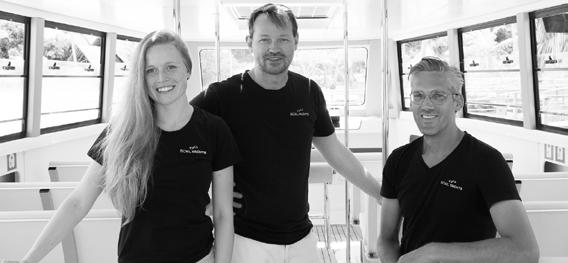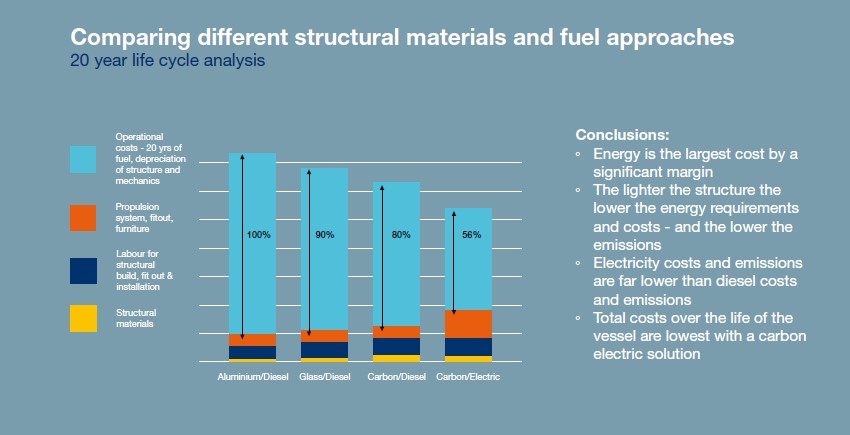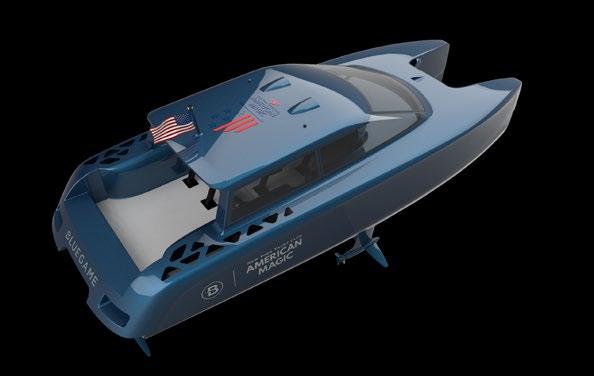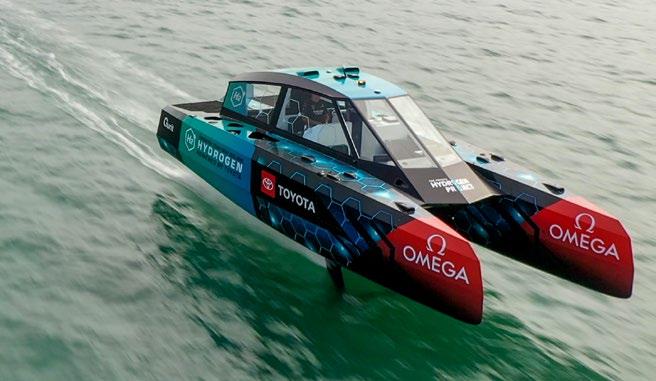
8 minute read
COMPOSITES ENABLING ELECTRIFICATION
from OneGurit magazine July 2023
by Gurit
HOW GURIT IS LEADING THE CHARGE
Driven by environmental concerns, country and industry emission reduction targets and the increasing price of oil, interest in the electrification of maritime vessels is growing across the commercial and recreational sectors, and across boats of all sizes. But there are challenges facing adoption, including shoreside infrastructure, technology, operational issues, regulatory frameworks, and cost.
It has become evident that composites are the enabler in the development of efficient, environmentally conscious, economically viable, fit-for-purpose vessels, especially in the 10-40m workboat/ ferry sector. Gurit is building up a sound knowledge base and expertise in this area.
The lightweighting advantage
Having worked on numerous electrification projects over the past few years, it has become clear to the Gurit team that achieving a lightweight composite structure is a key factor in an electric vessel achieving its performance, environmental and budget goals.
A high-strength, low-weight structure compensates for the weight of the energy and power systems, whilst still producing a boat that is lighter and therefore more efficient than the industry standard of a diesel aluminium vessel.
This is especially important in commercial/workboat vessels, which demand a specific speed or endurance range. And it applies to boats across the spectrum, whether ETNZ’s Chase Zero that achieves a range of 30 knots for 6 hours on a full tank of green hydrogen, or the Soel 12 passenger shuttle which travels at 6 knots for 24 hours on solar power.
We work very closely with Gurit to define our structural weight targets at the outset, and to help us monitor and manage the weight during the build process. For the Soel Shuttle 14 we decided on a production-friendly vacuum infused E-glass sandwich laminate, which balances durability and low weight.

Electrification brings with it additional equipment and fit-out requirements, such as cooling systems and fire barriers. Taking a lightweighting approach to the structure means this can all be accommodated without reducing the performance of the vessel.
If structural weight is managed successfully during the build, electric propulsion can significantly reduce operating costs, bringing long term economic as well as environmental gains.
Cost of material offset by reduced battery unit cost
In recent projects, Gurit Engineers have evaluated various construction options through energy modelling and cost analyses, and results have shown that high strength, low weight composite construction is the enabling technology for these projects. And as speed or endurance range increases, then carbon fibre becomes the natural choice.
Although carbon construction is more expensive than the alternatives of aluminium and traditional fiberglass on a per kg basis, the weight saving offered by carbon fibre means that not only are there fewer kilos of material in the finished product, but the cost of the material can be offset by the reduction in battery unit costs that it enables.
Most significantly, however, is what carbon fibre enables in terms of return on investment over the life of the vessel.
On a conventional commercial ferry, for example, energy consumption is by far the largest cost for the operator over the life of the vessel and can easily be 4-5 times the purchase price of the ferry. And a lighter vessel with an optimised number of battery units means reduced energy requirements and therefore reduced costs.
Second to energy consumption, vessel maintenance is a significant cost for the owner. Composites have lower maintenance requirements and offer exceptional longevity due to their corrosion and fatigue resistant properties.

Lightweighting in action
The Gurit team has a wide range of design approaches, technical strategies and advanced materials at its disposal to develop the right lightweighting solution for each project.
Weight management can be achieved by integrating the interior fit out; by ensuring structural performance is exactly where it is needed, rather than overdesigning the basic structure; and by choosing material wisely, for example heavier multiaxial fabrics for toughness whilst reducing manufacturing labour.
The Gurit team also considers the practicalities of the build and recommends techniques to complement the lightweight structural design. Large format, easily-handled composite panels can be used for flat surfaces such as the hull sides and decks, resulting in fast assembly and minimal parasitic weight at the joins. Vacuum infusion offers accurate resin uptake and avoids excess weight. Female moulds along with thermoformed foam core can be used on curved areas to further reduce resin consumption and weight.
Digitally designed composites for flexible and faster manufacturing
This extreme lightweighting approach is commonplace in the yacht racing world, where much time and money is spent on iterative optimisation, the cost of the structural materials is easily absorbed into the total project costs, and there is often no requirement for a financial return.
For many of the electric projects Gurit has been involved with, return on investment has been an early topic of conversation, especially in the case of commercial vessels. We are able to help customers successfully incorporate high tech and typically more expensive material into a commercial electric project in a practical and cost-effective way.
One option is our modular construction process, with intensive use of digital manufacturing, where all aspects of the design are modeled in 3D. Relying on that single shared point of geometry ensures accuracy and allows multiple work fronts to be underway at once – a vessel can be split into modules and assembled in almost any order. Not only does this approach meet the requirement for efficient and speedy manufacture, but it also provides flexibility for future builds and minimises the materials consumption for tooling jigs.

As our customers look to bring low emission vessels to market, they come to us with a genuine interest in ensuring the through-life environmental performance of the vessel: they want to know how the vessel will be built, how materials will be sourced, and they want to understand its environmental performance over time. This brings structural optimisation to the forefront of the design process in terms of matching materials to a particular operation.

Environmental gains
Clearly, one of the principal drivers for electrification is emission reduction. When combined with a renewable energy source, private and commercial electric vessels can achieve zero or reduced operating emissions.
Lightweighting with composites enables a vessel to be fully electric in the first place, and secondly allows the energy requirements to be optimised. Our digital manufacturing, modular design and large format panel approach ensures optimisation of materials and reduced waste.
In terms of entrained energy (energy needed to build a structure from raw materials including the energy used to extract materials from the earth and turn them into construction products), batteries are the single biggest contributor in an electric vessel. By using composites to reduce structural weight, and therefore reduce battery requirements, you reduce the entrained energy of the vessel.


End of life challenges
The composites industry is aware of the challenges it faces around the end-of-life of its structures, and more and more companies are getting involved in finding solutions. Gurit is involved in several industry initiatives investigating options, from sustainable bio-based materials which can be specified at the design stage, to the efficient recycling of composite materials at end-of-life.
Another concern often voiced is around the end of-life of electric batteries. They have great potential to be repurposed into second life batteries for use in less demanding applications, such as stationery energy storage. And most battery manufacturers have second-life applications and/or a recycling programme for many of the battery’s components.
Optimisation of the structural weight is key to successful electrification of marine vessels
Even as propulsion and energy sources improve, with batteries becoming smaller and lighter, low weight composites will remain vital if we want to continue to maximise the efficiency and environmental benefits of electric commercial ferries and workboats.
With a wide range of composite materials and technologies available, Gurit has the experience to help customers find the ideal construction solution for their particular electric vessel.









